by Ben Reade.
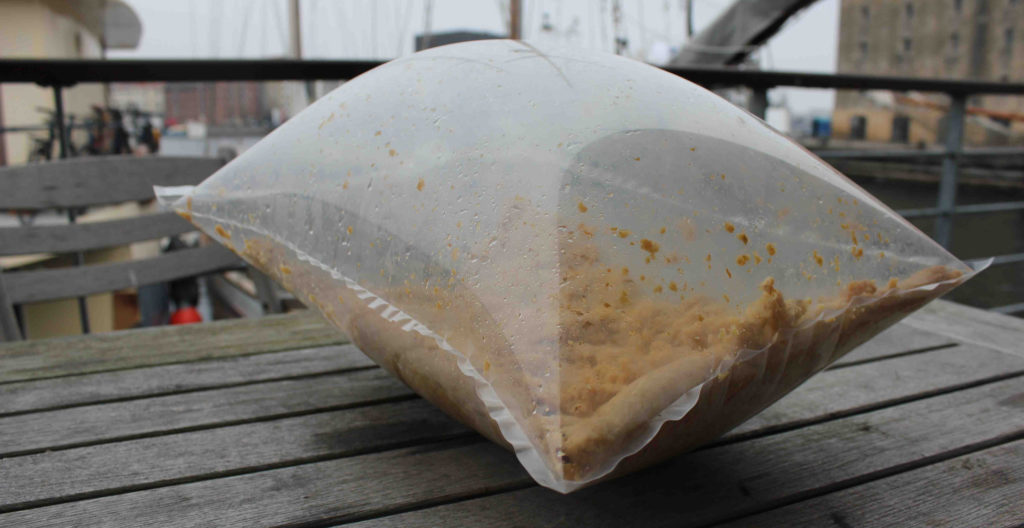
The world of microorganisms is vast and, relative to other areas of biology, poorly understood at a scientific level. Through millennia of experimenting humans have developed methods for using this invisible, but expansive world of microorganisms. The microbial world is defined by size, the multitude of species that this bracket covers is of varying taxonomic groups, and the variety within each is astounding. Taking the example of fungi, there are approximately 74,000 described of an estimated 1,500,000. Biologists have described around 3000 bacteria, which is an estimated 0.5% of the total bacterial species on planet earth (Boekout and Samson, 2005). Especially when compared to plants, where approximately 220,000 species have been described out of an estimated 270,000, these numbers give one an idea of just how hugely unexplored this invisible living world of taste biodiversity really is.
When talking of food, microorganisms have been used in a plethora of different ways and a comprehensive study of this would take many lifetimes. Microbial ecology differs drastically between locations and so fermented foods made in one place, if made with indigenous and autochtanous fermentation microorganisms are likely to taste very different to those foods made in another location: relatively short distances can have a huge effect. It is for this reason that microbial biogeography[1] offers those involved with food production a possibility to create foods which genuinely speak of the territory. Microbial cultures in food processing offer the gift of genuine expression of their geographical origin or ‘terroir’ alongside human intervention and processing technique or ‘millieu’ better than anything else.
Over the next few posts I will introduce to fermentation as a principle and we will try to classify food fermentation and drinks into some of their major categories. There are myriad different ways to classify this huge base of human knowledge and microbial activity (eg. by ingredients, by geography or by human culture). We will try and give the most general overview using the fermenting microorganismss themselves as our defining factor. Often a food fermentation may be carried out by a number of different species, either at the same time, or in succession. With fermentations involving wild microorganisms this is almost invariably the case. The ecology of fermented foods is a hugely complex and enormous subject, worthy of many lifetimes of study, here we’ll try and break it down, into a few blog posts. Due to the extreme level of ecological complexity within the world of microorganisms, it must be remembered that the classification framework offered is exaggerated in its simplicity and that, although pure microbial cultures do occasionally exist in nature, they are rare.
In biotechnology, fermentation has been defined as an anaerobic cellular process in which organic compounds are converted into simpler molecules and chemical energy (ATP) is obtained. In colloquial language fermentation has a much broader meaning, which tends to encompass the complex of enzymatic and microorganism stimulated breakdown of macromolecules within the fermentation substrate.
Fermentation was not clearly understood, (although it was carried out in a myriad of forms, all over the world for millennia) until Louis Pasteur (1822-1895) demonstrated the direct link between viable yeast cells and alcoholic fermentation, which at the time was met with great controversy (especially by advocates of ‘equivocal generation’ the now obsolete theory on the origin of life forms). Since Pasteur the definition has been defined as the conversion of sugar by yeasts into alcohol, carbon dioxide and energy. Modern definitions have become broader – Walker (1988) defines fermentation as a “slow decomposition process of organic substances induced by microorganisms, or by complex nitrogenous substances (enzymes) of plant or animal origin” (United Nations Food and Agriculture Organization (FAO)). This is the definition adopted by the FAO – it is broad enough to include enzymatic activity, which means that examples such as salt rich fish sauces (which frequently in the earlier stages are hydrolyzed by enzymatic activity alone) can be included.
Fermentation, for the good of this text, will be broadly defined as bioprocessing using microorganisms (particularly bacteria yeasts and molds) and the chemicals they produce (particularly enzymes, acids, gasses and volatile compounds) to achieve desirable characteristics (Nout, 2005, 13).
At NFL, one major area of interest is the F of various foodstuffs especially with the aim of creating and transforming flavours which can be used to increase the “vocabulary in our culinary language” (Rene Redzepi, 2011). Microbes have been proven in both ancient and recent history to be useful in transforming food products. Microorganism’s mechanisms of food transformation are still in many ways mysterious, both to science, and by those who work with them on a daily basis – perhaps NFL’s position between science and craft puts us in an unique position to explore and innovate in this area.
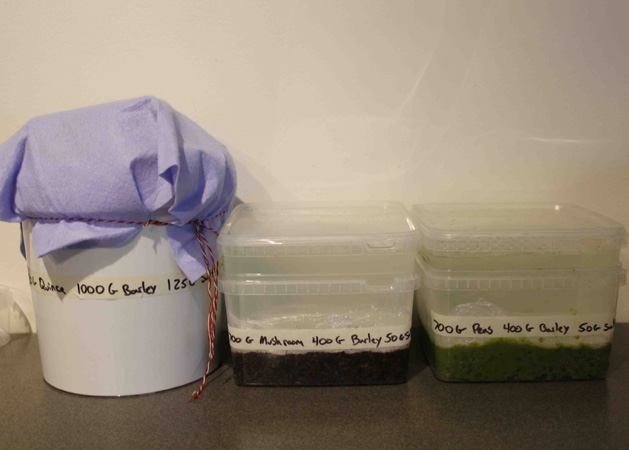
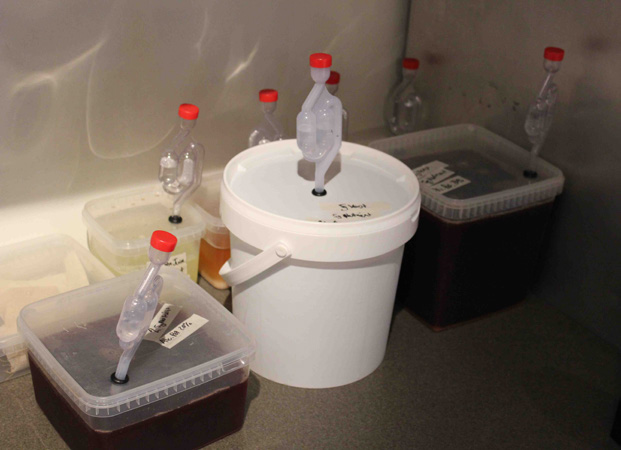
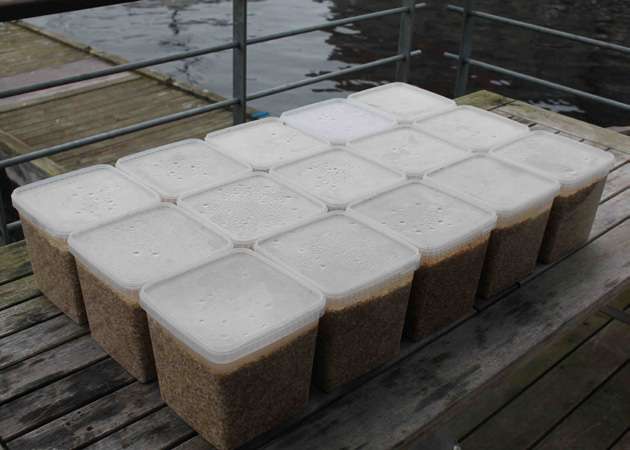
Perhaps some of the information included in the following posts can be useful to home cooks, chefs and food industry professionals in creating new products which can benefit the deliciousness of the food which they produce. One premise of this research is that few master artisans who make, for example, leavened bread, really have a grasp of the metabolic pathways of the yeast which they use to make the bread rise, but this does not stop them making excellent bread. The hope is that without understanding the complex microbiology at a molecular level, but with a level of understanding of the specific conditions which can encourage one or another microorganism (i.e. nutrition and limiting factors, optimal temperature, presence or absence of O2), it will be possible to make productive experiments within this broad field of food fermentation. This text is written in the hope that with a little more knowledge of these complex bioprocesses people, with patience and experimentation, can use a plethora of wild and cultivated MO to produce high quality traditional and novel foods.
At NFL the study of fermentation arose from a search for new flavours compatible with NNC. By using something like a kombucha mother[2] to transform a liquid; e.g. carrot juice; we are utilizing what is essentially an extremely complex bio-machinery to assemble many flavor compounds (microbial metabolites, products of macromolecule hydrolysis and chemical reactions) that are practically impossible to assemble in any other way. There is a compelling sense of locality about fermented products, an identity and flavour that, due to local MO biodiversity is singular to the place it is produced. For this reason it is felt at NFL that fermented products offer a unique possibility for gastronomic representation of local biogeography. For NFL there is also a pleasure in reworking techniques that have been used throughout history in the Nordic region for increasing of desirable characteristics and preservation of foods.
It is of vital importance to understand that fermentation is not a technique that humans have invented, it is a natural process performed by the invisible world of microorganisms which we as humans have learned, and are still learning, to manipulate. Seen from a larger perspective we are one drop in an ocean of species, living and enjoying the metabolites of microorganisms.
Many other species enjoy fermentation. Just to demonstrate that we as humans are not alone, here is one notable example: the Malaysian pen-tailed treeshrew (Ptilocercus lowii), for our purposes is a particularly interesting species for its behavior[3]. This tiny primate is a completely reliant on alcohol. Every night they can be found guzzling down the equivalent of multiple bottles of wine, in the form of alcoholically fermented nectar in the flowers of the bertam palm (Eugeissona spp.). The interesting thing is, that the bertam palm relies on the treeshrew’s penchant for alcohol for pollination, the primate unwittingly takes the pollen from one flower to the next as it carries out its nightly routine. But the inter-reliance goes further still, the yeasts fermenting the nectar sweetened water have to travel to each new flower to start their work fermenting, thereby proliferating and expanding their population. This is accomplished by traveling on the treeshew’s nose as it moves in its nightly routine, going from one alcohol source to the next. This is just one example demonstrating the highly inter-dependant and ecological role that plants, animals and MO have to each other; they need each other to exist (Weins et al, 2008).
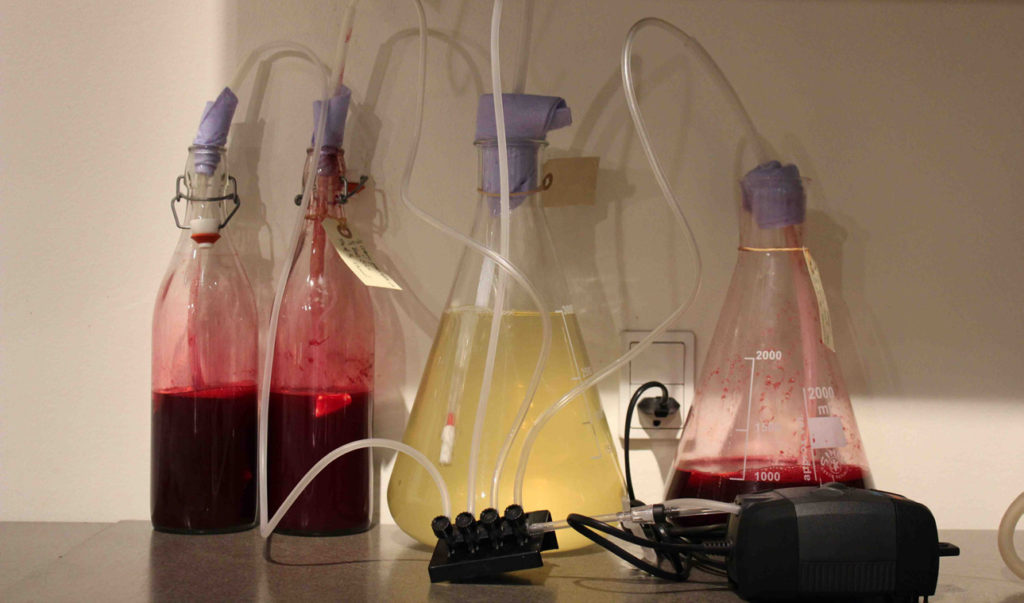
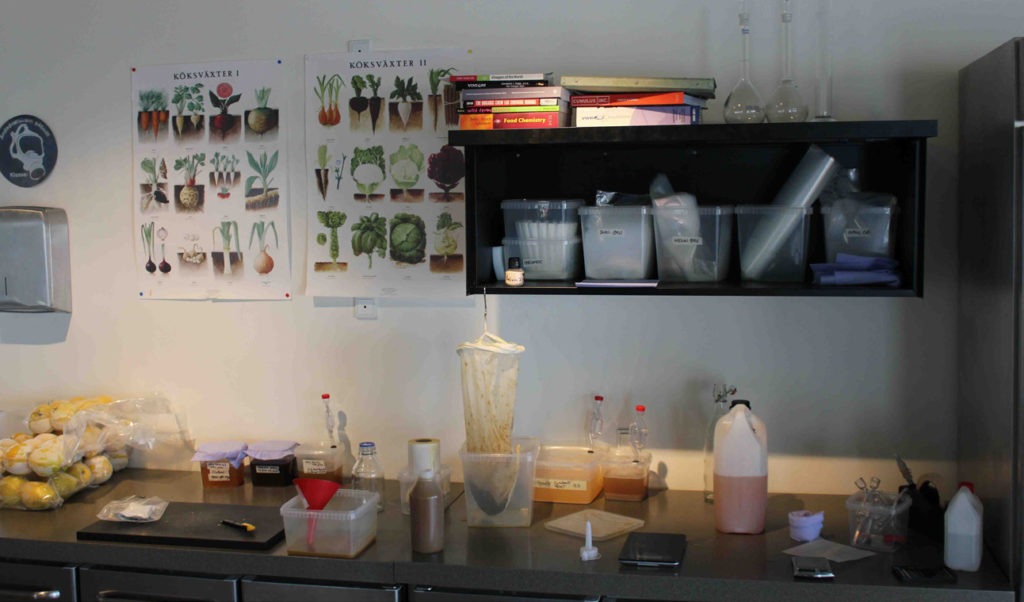
Over time, mankind has evolved systems of preservation. Those which involve fermentative processes, may often have been fortunate accidental discoveries, where a food product mixed with a certain amount of (for example) water or salt, produced an interesting sour, alcoholic or otherwise desirable quality. Once the maker began to understand exactly what he had put in this specific mixture, they would have tried to reproduce the results, and successfully preserved food would have provoked an increase in the consumer’s health, and the culture of, for example leavened bread or primitive beer, would have spread very fast. Changing and evolving as it spread over the cultural and geographical landscape.
Humans are also entirely dependent on microbial ecology to survive. The human body is a vehicle for many more MO than it has human cells – your body has a minimum of around 10 times as many microbial cells as human cells, mostly in the large intestine of the gut. Without our intestinal micro flora we quite simply could not survive, they help us especially in digesting foods; in return we supply them with a habitat and food. Taking the endosymbiotic theory of unicellular organisms as the evolutionary starting point for all other organisms we can begin to grasp the importance of the inter-reliance between species. As is eloquently described by Margulis and Dorian Sagan in their book microcosmos,
“Eventually some of the prey evolved a tolerance for their aerobic preditors, which then remained alive and well in the food rich interior of the host. Two types of organisms used the products of each other’s metabolisms. As they reproduced inside the invaded cells without causing harm, the preditors gave up their independent ways and moved in for good.”
Margulis and Dorian Sagan in Sandor Ellix Katz (2011)
We humans have learned to exploit many microorganism for our benefit; historically this has mostly been in food production, although more recently in chemical synthesis for medicine and industry. Here it is proposed that the best way to classify the innumerable food fermentations is by the type of microorganism utilized. Therefore we need to know how to classify the microorganism themselves. It is by these groups along side the food fermentation substrate, that we offer this coarse classification of food fermentation. Now, over the next few posts we can go on to have a look at classifying our ‘living’ foods, using some examples to illustrate each, and listing some of the NFL experiments that were carried out during this ongoing investigation. Tomorrow we start with alcohol, so get ready to fill your glasses.
Bibliography
Boekout, T. and Samson, R. (2005) Fungal diversity and food, in Nout, M.J.R., De Vos, W.M., Zwietering, M.H. (eds) Food Fermentation pp. 29-44, Wageningen Academic Publishers, The Netherlands.
Katz, S.E. (2010) Fermentation as a co-evolutionary force, in Procedings of the Oxford Symposium on Food and Cookery‘Cured, Fermented and Smoked Foods’ pp. 165-174, Prospect Books, UK
Nout, M.J.R. (2005) Food fermentation: an introduction, in Nout, M.J.R., De Vos, W.M., Zwietering, M.H. Food Fermentation pp.13-21, Wageningen Academic Publishers, The Netherlands.
Redzepi, R. (2011) The Science of ‘Deliciousness’ on BBC HardTalk http://news.bbc.co.uk/2/hi/programmes/hardtalk/9669147.stm Retrieved [6/1/12]
Weins, F. et al (2008) Chronic intake of fermented floral nectar by wild treeshrews, Proceedings of the National Academy of SciencesUSA 105 : 10426.
[1] Biogeography is the study of the distribution of species in geographical space.
[2] Kombucha is a Central Asian fermented drink. The mother is a layer of transparent cellulose containing a mixture of yeasts and bacteria. This ‘mother’ is also known as a SCOBY (Symbiotic Culture of Bacteria and Yeasts).
[3] The treeshrew is also the earliest living ancestor of all primates
About the author
My Name is Ben Reade, I’m a chef from Edinburgh, Scotland, and for the past 3.5 years I have been studying at The University of Gastronomic Sciences in Pollenzo, Italy. For my final thesis, I came to Nordic Food Lab to research many subjects where my varied interests inerlaced with those of the Lab. The research arose out of time spent at the Nordic Food Lab between 29 September and 22 December 2011. The aim is to describe NFL’s current research to both chefs and non-specialized readers, explaining and coding the creative and scientific methodologies employed during the research at NFL, exploring their application in food experimentation and innovation. Over the next month or so I will be breaking down this thesis into manageable blog-style chunks, this is chunk 6ish of around 25 I hope you find it interesting.
